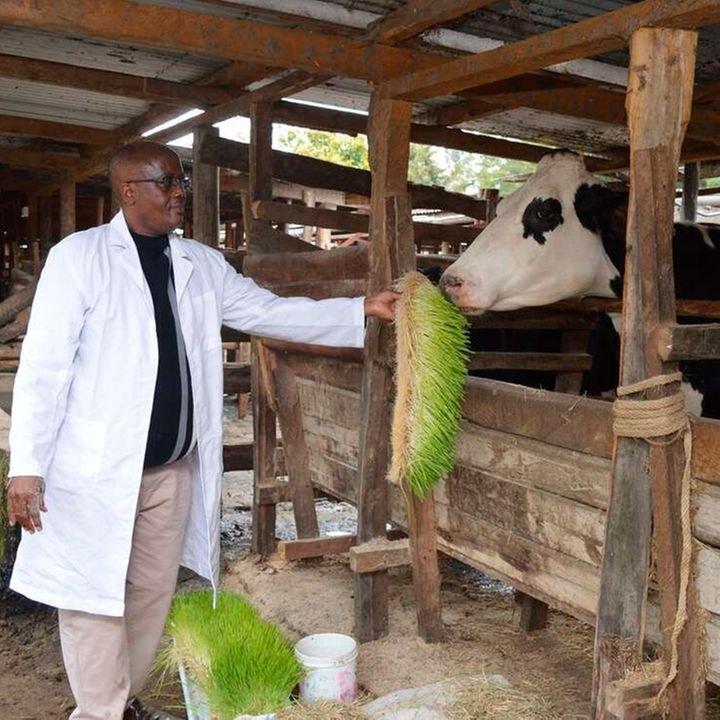Africa-Press – Nigeria. Do you know that the dairy cow operates on a strict 24-hour routine that is important to its production and productivity?
Production is the total output of the animal over a defined period of time. Productivity, on the other hand, is the animal’s output for every unit of input. For instance, we know the average milk production of a dairy cow in East Africa is 10.1 litres per day. Such cows are fed about four kilogrammes of daily meal in a day.
The productivity is, therefore, about 2.5 litres of milk. It means that for every kilogramme of dairy meal the animal eats, it produces 2.5 litres of milk. This is low because in well-managed cattle, the productivity should be about 5.8 litres for the same type of animals.
This translates to a daily production of 35 litres of milk and 10,675 litres for an annual lactation of 305 days. I have seen cattle with good genetics, picked randomly from farmers, with productivity of 2.5 litres or lower but when they are put under good management; they shoot to 5.8 litres per kilogramme of dairy meal.
Nutrition
The above analogy underscores the poor management of dairy cattle locally. Most people peg poor performance to nutrition alone. They forget or are not aware that an animal’s production performance is determined by its genetics, nutrition and management.
Deficiency of knowledge on the daily behaviour of a dairy cow lowers the productivity of the animal and denies farmers much-needed earnings. It also denies the consumer the much-valued milk.
We closed the year for our “on-farm dairy training programme” last week. Farmers who recently participated in our “on-farm dairy training programme” workshop were impressed by Dr Kibet’s training on the daily routine of a dairy cow.
He started with a rapid fire of questions that left the participants awed. “Do you know dairy cows are creatures of strict habits? Do you know they have their daily routine that they follow diligently? Do you know if you disrupt the routine, the cows will deny you milk because they will not be able to manufacture it?” Kibet asked passionately.
Milk production
Out of the resting hours, 7-10 are allocated to ruminating. It is these hours that are very critical to milk production. A cow that does not ruminate efficiently will produce very little milk. Therefore, if a cow does not rest, then milk production is proportionately reduced.
Benefit of rumination
Rumination aids in the digestion process in the rumen. The animal releases sugars from the feed it has eaten. The sugars are used by bacteria in the rumen to produce proteins for the bacteria and for the cow. The cow finally absorbs both the proteins produced and the bacterial proteins and uses them together with the sugars to manufacture milk.
Cows produce up to three kilogrammes of bacterial proteins. It is the reason why they are able to produce 10-15 litres of milk from good forage without supplementary proteins from the dairy meal. Give your cow good forage and sufficient resting time for optimum productivity.
Feeding takes between three and five hours and the cow eats 9-14 meals. When your cow stops feeding at the trough, it does not mean it is full. It means it is done with its portion of the meal. It will be coming back periodically for the remaining eight portions.
Loss of water
Dirty water deters cattle from drinking and also increases the drinking time. Milk contains 87.3 per cent water. Dairy cows feel thirsty after milking due to the sudden heavy loss of water in milk. They require 90-120 litres of water daily if giving 35 litres of milk. Clean, cool water should be provided at all times.
Cows are social animals. They give themselves between two and three hours for social interactions including necking, licking and touching each other. They will sniff and mount each other especially when one is on heat.
About 2.5 hours are provided for management practices including health checks and interventions, cleaning and milking. Most farmers disrupt the cow routine without understanding they are inadvertently sabotaging the productivity of their farming business.
Productivity
The productivity is, therefore, about 2.5 litres of milk. It means that for every kilogramme of dairy meal the animal eats, it produces 2.5 litres of milk. This is low because in well-managed cattle, the productivity should be about 5.8 litres for the same type of animals.
For More News And Analysis About Nigeria Follow Africa-Press







